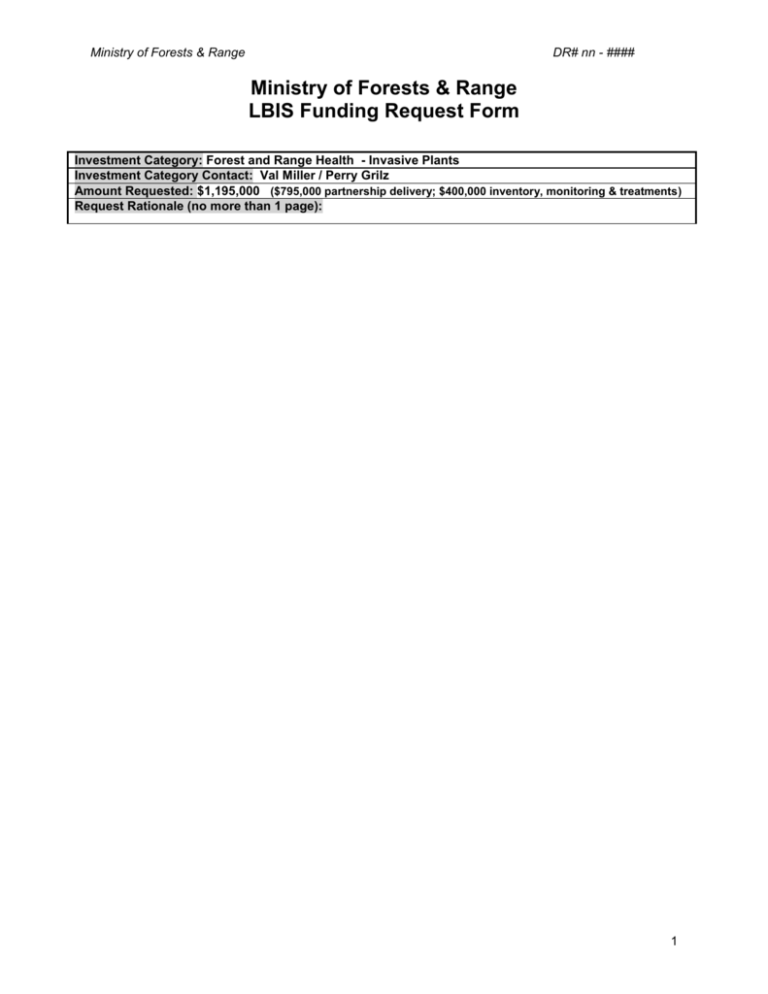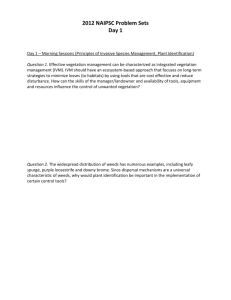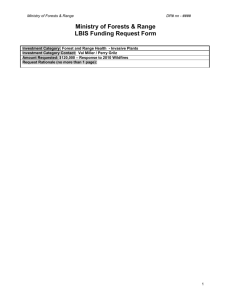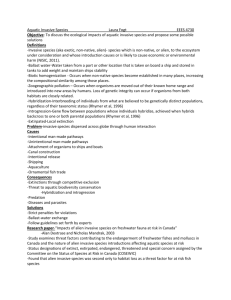MFR_LBIS_ Business rationale_Invasive Plants 2011
advertisement

Ministry of Forests & Range DR# nn - #### Ministry of Forests & Range LBIS Funding Request Form Investment Category: Forest and Range Health - Invasive Plants Investment Category Contact: Val Miller / Perry Grilz Amount Requested: $1,195,000 ($795,000 partnership delivery; $400,000 inventory, monitoring & treatments) Request Rationale (no more than 1 page): 1 Ministry of Forests & Range DR# nn - #### Business rationale (include benefit/cost impacts): The issue: The introduction and spread of invasive plant species adversely affects ecological, economic, and social values in British Columbia. Invasive plants directly impact or threaten forest and range productivity, ecosystem functioning, riparian and aquatic habitats, and they affect all of the FRPA resource values. Some invasive plant species reduce forage availability by up to 90%, restricting opportunities for livestock grazing and displacing wildlife. Invasive plants directly compete with forest seedlings for light and nutrients, and respond favourably to silviculture treatments, soil disturbance and fire. Other species are toxic to livestock and/or people, while some have barbs or thorns that affect movement corridors and recreational access. Five provincial Acts and seven federal Acts and Regulations address invasive plant management in BC. Provincially, the Weed Control Act and the Forest and Range Practices Act directly address invasive plant management on Crown land. Under the Weed Control Act and as the occupier of Crown land, MFR is responsible for controlling invasive plants (noxious weeds) listed under regulation. A total of 60 species are currently listed under these two provincial Acts. Size and scope: Legislated invasive plant species occupy over 145,000 hectares of Crown land (2008) and are found in almost every BEC subzone, however there are limited landscape level inventories and this estimate is considered conservative. MFR has been involved in invasive plant management for over 50 years, using an integrated pest management approach. A minimum of $1.2 million is required to address new invaders and contain provincial priority species on Crown land; however this does not begin to address all legislated species. The provincial government is committed to addressing invasive plants through integrated pest management approaches and collaborative partnerships, including third party delivery at the local level. Since the late 1980’s, MFR has been working collaboratively and developing partnerships with regional weed committees. These committees include local, provincial, and federal government and non-government agencies and organizations; First Nations; ministry clients; and the public. Through collaboration, MFR has supported the development of First Nations Invasive Plant Partnership Programs, and participated in pooled resource delivery models. The ministry delivers invasive plant management through operational inventory, survey, treatment, and monitoring activities, and the development of new biological control agents for effective long-term control and rehabilitation of heavily infested areas. Benefit/cost: A recent economic study completed for the Invasive Plant Council of BC (2009) identified economic impacts of $65 million/year from only six invasive plant species and projected this to increase to $139 million by 2020 if no management action is taken. $42 million in losses were identified in Montana due to knapweed species alone (Hirsch, S.A. & J.A. Leitch, 1996). The benefit/cost ratio in BC of biological control treatments for diffuse knapweed was determined to be 17:1 and 185:1 for hawkweed species (IPC BC 2009). Other studies in the U.S. have identified benefit/cost ratios for controlling invasive plants through chemical and mechanical means ranging between 1.5:1 to 10:1. Achieving LBIS goals, objectives, priorities & multiple benefits: the investment in invasive plant management directly supports all three LBIS goals: 1) maximum productivity: controlling infestations and minimizing spread to new areas protects current forage productivity while improving forage quantity and quality in heavily infested areas through the application of biological control measures (where applicable) and enhanced management practices through stakeholder engagement; 2) well-managed resources: controlling invasive plants improves ecosystem functioning and prevents impacts to native vegetation and wildlife; 3) coordinated and integrated planning: MFR’s Invasive Plant Program has been a leader in collaborative, regional/local level integrated planning and delivery of effective on-ground programs. Our partnership agreements and collaborative efforts with committees, including land management agencies and First Nations, has leveraged additional partners and resources outside of government. This request for funding is for two components: NOTE: these two components are intricately linked. If part a) is not supported, the amount required in b) would increase proportionately. a) Maintenance of weed committee/regional district partnerships and pooled resource delivery models ($795,000) through STOB 77; and b) Operational resources to address inventory, monitoring and treatment priorities that are not covered through established partnership approaches ($400,000). The most effective window for treatment is late April to fall frost, efficacy is increased with treatments performed prior to seed set. Inventory projects are best accomplished in June – August; and monitoring is throughout the growing season. 2 Ministry of Forests & Range DR# nn - #### Amount Allocated (to be filled out by FPIB): Allocation Rationale (to be filled out by FPIB): 3 Ministry of Forests & Range DR# nn - #### 4









